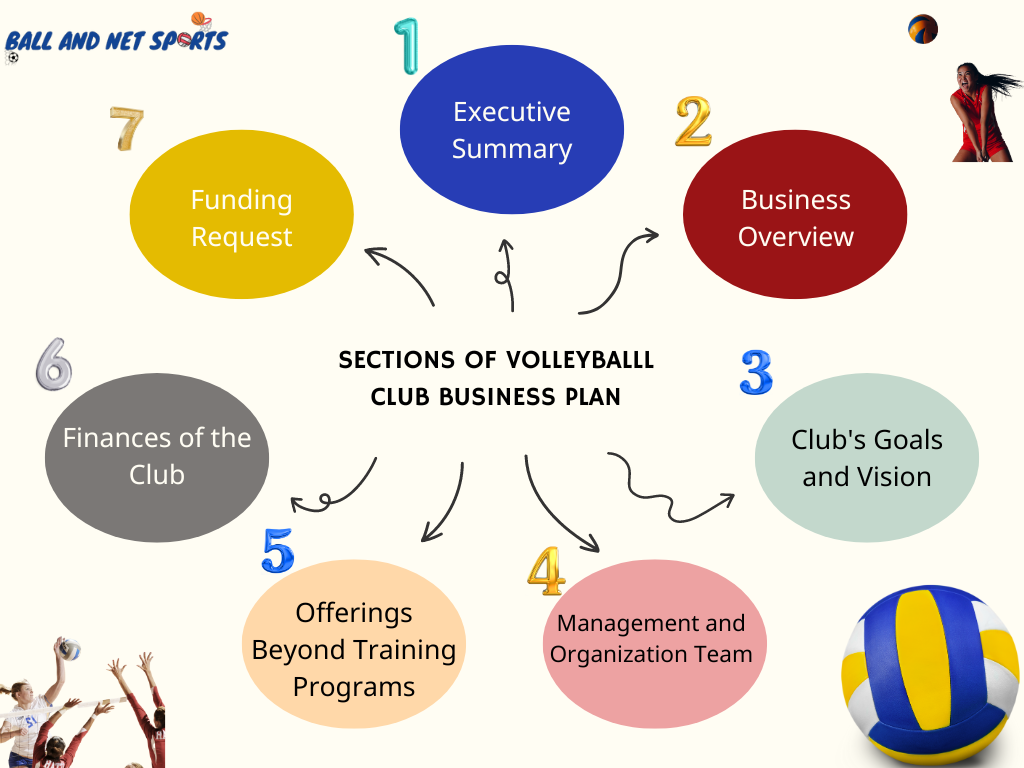Volleyball Club Business Plan (This is How Top Clubs Attract Investors)

Starting a volleyball club is nothing less than a herculean task. You try to focus on one thing of the business just to know that the other things are completely messed up.
For all the important things of your club, you need money. And to get this money you need a winning business plan for your volleyball club that must impress all the investors out there.
Here is how you write an impressive business plan that will attract investors to your vision.

Executive Summary: Setting the Tone
When you walk onto a volleyball court, that opening serve – the initial contact, the anticipation, the strategy – speaks volumes about the game to come.
Similarly, the Executive Summary of your business plan sets the stage for everything that follows.
It is not just an introduction but a powerful statement of intent that will keep investors hooked on your business plan. Here’s how you craft a compelling executive summary:
Mission Statement
Often referred to as the heartbeat or the soul of your club, the mission statement articulates the reason your club exists.
Is it to foster talent at a grassroots level, provide a community space for enthusiasts, or elevate the game’s standards in the region? This isn’t just a business descriptor; it’s a declaration of your club’s values, aspirations, and commitments.
Write your club’s mission statement to get things started.
Business Opportunity
Business opportunity is the most important thing in any business plan.
This is where investors are most focused since they want to see even if your business is financially viable.
If they see an opportunity, they will be all up for investment. Otherwise, it could be curtains.
Put down a slight overview of the business opportunity in the executive summary (Don’t worry if it is too short here since we will cover this part in detail in the later stages of the volleyball club business plan.)
The key to a successful business opportunity is to address the gaps that are currently present in the volleyball club industry.
Aim for the things that are not offered by other clubs so that investors see that you are following an innovative approach. Innovative objectives of volleyball clubs can lead you in the right direction at this stage.
Financial Projections
For investors, money matters.
While passion drives the vision of many volleyball clubs, financial viability ensures sustainability.
In the executive summary, offer a concise yet impactful snapshot of your club’s fiscal roadmap for the next 3-5 years.
And do not make imaginary castles. Back up your stats from data so that investors know that your club has real potential.
These were the things that you needed to include in your volleyball club business plan’s executive summary.
Now let’s see what will be in the main body of the plan, as it will explain the content of your executive summary in detail.

Business Overview: The Backbone of Your Plan
A building stands tall not just because of its visible structure but because of the deep foundation and the hidden framework that supports it.
Similarly, the story and the fundamental principles of your volleyball club are the backbone of your entire operation.
This section of the business plan allows stakeholders to understand the origins, aspirations, and placement of your club within the broader industry landscape.
Here is what you need to write in this section:
Genesis of the Idea (Start with a Story)
Every establishment has its genesis story. How was the seed of starting a volleyball club sown? Was it an unquenchable passion for the game? A personal journey of a volleyball enthusiast who saw a lack of proper training facilities? or something else?
Narrating this story not only offers insight into the club’s roots but also adds a personal touch, making it relatable and memorable.
Having an unforgettable story will help you in capturing the eyes of the investors in the crowd since investors are always busy with other business plans. So a good story will make your plan stand out.
The Torchbearers, The Founders
Behind every club, there’s a team or an individual whose vision and determination bring the idea to life.
Adding the team to your volleyball club business plan adds huge credibility to the document.
Investors need to know about people who will be dealing with their money.
Detailing the founders’ backgrounds, their motivations, and their aspirations helps paint a picture of the club’s leadership.
Positioning within the Volleyball Ecosystem
No club exists in isolation. It’s part of a vast, interconnected network of institutions, players, leagues, and more.
So, where does your club fit in?
Is it a nurturing ground for young talents who aim to play at national or international levels? Is it a haven for enthusiasts who simply love the game and wish to play recreationally?
Or is it a hybrid model catering to both serious athletes and hobbyists?
This positioning helps potential members, partners, and investors understand the club’s primary focus and its value proposition.
Pulse of the Industry
The dynamic world of volleyball, like all sports, is ever-evolving. From rule changes and training methodologies to technological interventions like wearables for performance tracking or VR for game strategy, the landscape is in constant flux.
Include how volleyball’s popularity has surged or shifted in recent years in your region or globally. Are there new training methods or tech tools that are reshaping coaching techniques?
Being informed about these trends and reflecting them in your plan not only shows that you’re connected with the industry’s pulse but are prepared to adapt and innovate.
But must remember to connect all of these things with how it will help your club in making more money as it will inspire more investors.
Business Goals and Vision: Charting the Path
You need to put detailed business goals and vision in this section of the business plan.
This section is typically divided into the following subsections:
Immediate Goals The First Milestones
Short-term objectives, or the goals you aim to achieve in the immediate future (typically within the next year), serve as important stepping stones toward the larger vision.
They give your team something tangible to rally around and provide clear metrics for success. If your goal, for instance, is to train 200 players in the first year, it means you’re prioritizing outreach, perhaps targeting schools or community centers, and ramping up coaching capabilities.
Such specifics not only provide clarity but also allow for actionable strategies to be devised. These immediate goals help investors to see if you have a real plan or if you are just another volleyball club trying to get funding for no good use.
Long term goal of the volleyball club
This section is all about the long-term business vision.
How do you see when you project your club’s journey a decade down the line?
Is it transforming from a local volleyball club into a renowned sports academy? Is it expanding horizons by not just focusing on volleyball but branching into a multi-sport complex?
Or perhaps it’s about international recognition, where partnerships with global clubs lead to exchange programs, exposing local talent to international standards of play.
These are some of the examples of how you can shape your club’s direction in the long run that could impress investors.
Also, investors like it when they see businesses making a long-term strategy. This way, they understand their money will go into the hands of those who are serious about doing business.
Aligning the Goals with Vision
It’s vital to ensure that immediate goals align seamlessly with the grand vision.
For example, if the long-term vision involves partnerships with international clubs, then immediate objectives might involve participating in international tournaments or establishing relationships with international coaches.
This alignment ensures that every short-term achievement is a step closer to realizing the grand dream.
Management and Organization: The Team Behind the Dream
A dream, no matter how grand, is only as good as the team that’s tasked with turning it into reality.
The structure, expertise, and cohesion of this team can determine the success or failure of any endeavor.
For a volleyball club, this translates into the management and organizational team that lays down strategies, makes critical decisions, and ensures that the club runs like a well-oiled machine.
Investors are always keen to look at this section of your business plan.
Here is what you need to include in this section of your business plan.
Hierarchical Structure
Clearly illustrating this hierarchy ensures that responsibilities are well-defined and there’s no ambiguity about the decision-making process. It helps streamline operations and fosters a sense of order and discipline.
Typically this part has the following positions of the club
- Founder
- CEO/President
- Vice President
- Advisors and Mentors
- Coaches
- Support Staff
While these are the important positions to add to the hierarchical chart, you can add more people to it based on your club structure.
Service or Product Line: More Than Just a Court
Every successful venture is anchored not just by its primary offering but by the holistic experience it provides to its audience.
For a volleyball club, while the main attraction might be the sport itself, a number of offerings surrounding it can significantly elevate its value proposition and attract a wider audience. This section delves into the varied services and products that make your club a comprehensive sports entity.
Training Programs Catering to All
Typically volleyball clubs start programs for various skill levels. These programs are classified as:
- Club training
- Volleyball camp
- Volleyball clinics
If you have innovative ideas that can let investors know that your club is not just another facility, well and good. Otherwise, you can explore innovative volleyball ideas that will surely help you in securing the much-needed funds.
Merchandise
Merchandise is more than just a revenue stream; it’s a means of building community and identity. Custom jerseys, for instance, give players a sense of belonging, turning them into club ambassadors of your business. The same is the case with equipment that your club may offer.
Clearly put down what type of merchandise, if any, you will launch with your club so that investors can see your plans.
Partnerships
Volleyball isn’t just about technique and stamina; it’s about overall well-being.
Partnerships with nutritionists ensure that players get diet advice tailored to their needs, enhancing their performance and recovery.
Collaborating with physiotherapists can aid in injury prevention and rehabilitation, ensuring that players remain in peak physical condition.
Such partnerships signal the club’s commitment to its players’ holistic development, ensuring that their needs, both on and off the court, are catered to.
Also, this section will let potential investors know you care about players (who are the customers of your club).
Having a customer-first approach will surely impress all the potential investors.
Membership Models
One size seldom fits all, and this holds true for volleyball club memberships too. Will your club offer a basic membership, granting access to facilities, and a premium one that comes with added perks like personalized training sessions or nutrition consultations?
Or is there a loyalty program where long-standing members get special benefits or discounts on merchandise?
Such tiered memberships not only address the needs of different audience segments but also create an incentive for deeper, prolonged engagement with the club, which will eventually increase your club’s profitability potential and hence its chances of getting funds from investors.
Financials: Keeping Score

Many potential investors directly jump on this section of your business plan.
They want to see the ROI of their investment. That is why this part of the plan must focus on the details of the finances of your club.
Just as a coach keeps a close eye on the scoreboard, a business owner needs to be meticulous about their financial health.
The financial section of your business plan doesn’t just give you a snapshot of your current standing but also projects the trajectory you’re on.
This section serves as the backbone for investors, potential partners, and even for your internal team to understand the financial stability and projections of your volleyball club.
This section usually includes:
Initial Setup Costs
Infrastructure costs of acquiring land or renting a facility, setting up indoor or beach courts, and ensuring proper lighting and seating arrangements all come under this section.
There’s also the cost of equipment from volleyballs to nets, posts, and more.
Plus, don’t forget about the licensing and permits required to legally operate your club. Providing a detailed breakdown of these initial costs gives a clear picture of the investment needed to kickstart the club.
Monthly Operational Costs vs. Expected Revenue
Once the club is up and running, there will be recurring expenses: staff salaries, utility bills, equipment maintenance, marketing expenses, and more.
On the other side of the ledger, you’ll have revenues, primarily from memberships, merchandise sales, event tickets, etc.
Comparing monthly expenses against expected revenue gives insights into cash flow. Put all of this in detail in your business plan.
Profit and Loss Forecasts
Beyond the monthly view, it’s vital to project the club’s financial health over a more extended period, typically a year or even 3-5 years.
This forecast isn’t just about extrapolating current numbers but also taking into account future expansion plans, hiring more staff, adding more services, or even potential economic factors that might affect member enrollments.
Potential Risks and Mitigation Plans
Economic downturns, unexpected infrastructure repairs, changes in local regulations, or even something as unprecedented as a pandemic can affect the club’s finances. And all of this can impact the volleyball club.
It’s crucial to identify these potential risks and, more importantly, have a game plan to navigate them. This not only ensures the club’s resilience but also instills confidence in potential investors or partners.
Usually, you need to add the following items in the financial projections section of your business plan.
- Projected Income Statement
- Projected Cash Flow
- Projected Balance Sheet
- Accuracy and Assumptions
Potential investors put a detailed eye on the financial projections of your volleyball club, not to mention this projection is also important for seeking loans.
It showcases the club’s growth potential, providing assurance on the return on investment or the ability to repay loans.
Investors aren’t just putting money on your current status but more on where you’re headed, making this section invaluable.
Regular Revisits and Updates
As time rolls on and as the club grows, actual performance might vary from the projections.
Economic landscapes change, new competitors emerge, or global events (like a pandemic) can alter the course.
Therefore, it’s crucial to revisit and update these projections regularly, aligning them with the latest data and market conditions.
Funding Request
This is part of the business plan for which you have written all the previous things. It is for this section that you wrote the whole convincing document.
So this is the time to ask for funding from investors and kick off a mutually rewarding journey.
The Significance of a Funding Request
Just like a team’s appeal for a crucial point in a tight match, your funding request is an appeal to potential backers. It’s your opportunity to articulate your financial needs, ensuring potential investors or lenders comprehend the value they’re getting and the difference their support will make.
But a question may arise. How much money should you ask for?
Here is what you need to do:
Clarity is Key
Start with the exact amount you’re seeking. Whether it’s for infrastructural upgrades, hiring elite coaches, or expanding the club’s reach, pinpoint the amount down to the last detail.
Allocation Breakdown
Provide a clear breakdown of how the funds will be utilized.
For instance, specify percentages for infrastructure, marketing, personnel, and other key areas. This gives confidence to investors that their money will be used in the right way.
Repayment or Equity Options
This is for those who are writing business plan to take a loan.
Debt Financing: If you’re taking a loan, outline the terms of repayment. Highlight the interest rates, tenure of the loan, and how the business’s cash flows will support this repayment.
Equity Financing: If you’re offering a stake in your club in exchange for funds, specify the percentage of equity you’re willing to part with. Provide potential investors with a clear picture of what this equity means in terms of control, dividends, and future value appreciation.
ROI for Investors: Investors are essentially taking a bet on your club. Therefore, outline the potential Return on Investment (ROI). Highlight how and when they can expect a return, be it through business growth, profit-sharing, or an eventual buy-back of their equity.
Final Words
Writing the business plan is the first step in starting your volleyball club.
Remember, while the numbers matter, personal stories and passion go a long way.
Share the journey of your volleyball club, its impact on the community, and its potential to shape future sporting heroes.
Let potential investors see beyond the financials and connect with the heart and soul of your club.
This is how you write a winning volleyball club business plan that goes a long way.

Ahmed is the founder of Ball and Net Sports, a platform where he writes about volleyball.
As a professional volleyball player who has participated in various national and international level volleyball competitions, he loves to teach other volleyball enthusiasts about the game.
He is now a professional volleyball coach who organizes volleyball camps and social events for talent hunting for top volleyball teams.
As a volleyball talent-hunting specialist, he loves to teach people how they can make their game better in the fast-paced volleyball environment where it is extremely difficult to get quality content free of cost.



